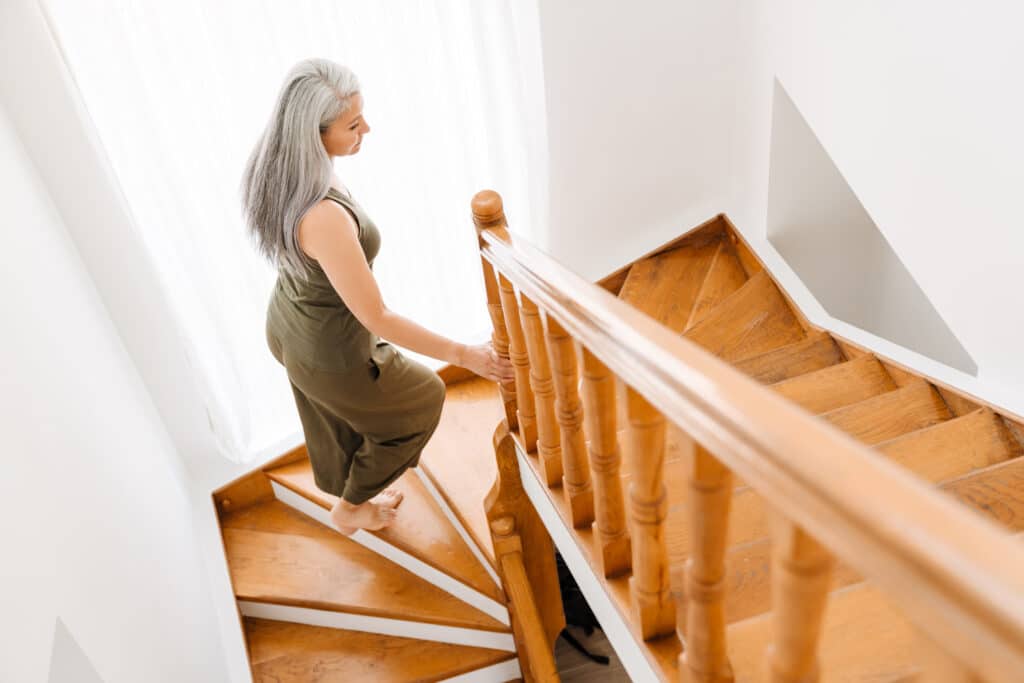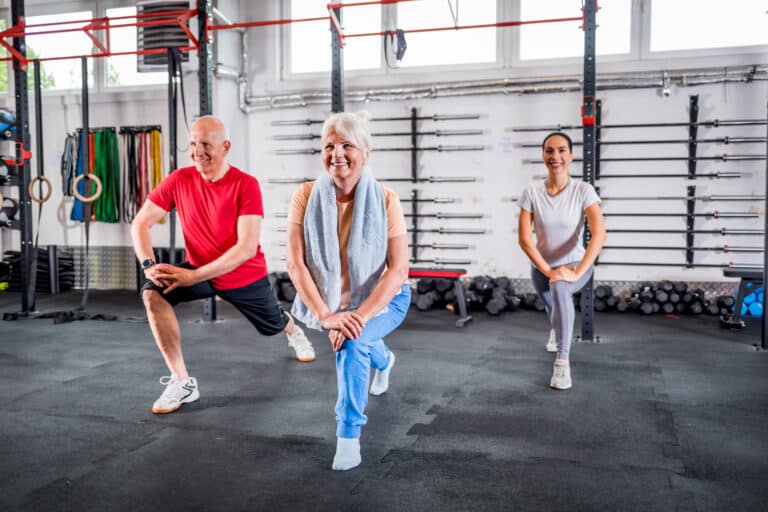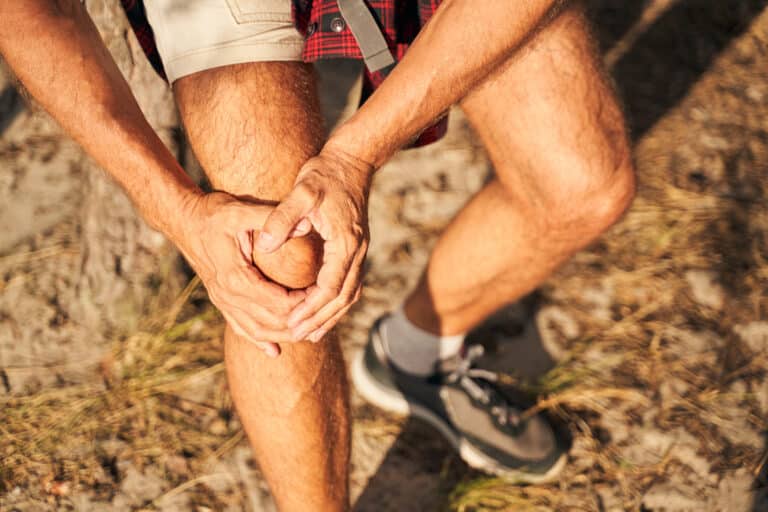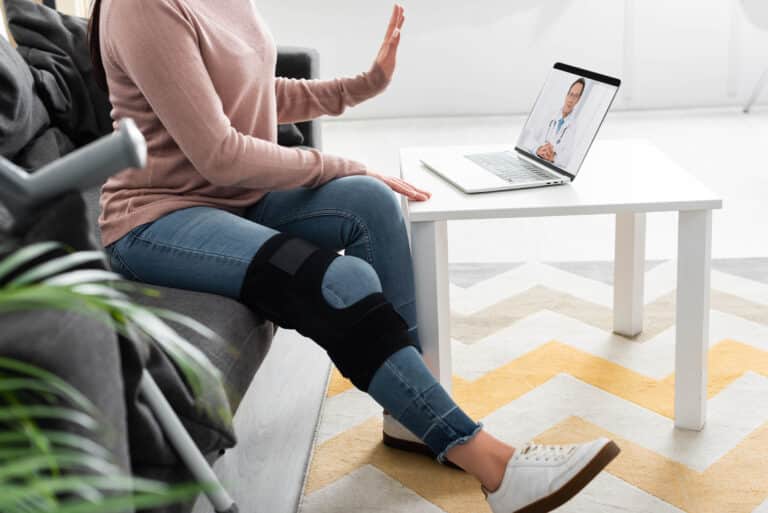Is your regular journey up a flight of stairs starting to feel like a mountain trek due to knee pain? Many older adults experience knee pain when climbing stairs, but there are ways to treat this common problem.
Knee pain isn’t a mandatory part of aging and is also not something you should ignore. Having helped many older adults improve their knee health through physical therapy, I will share some of the most important ways to improve knee pain when going upstairs.
In this article, we’ll explore the causes of knee pain when going up stairs, discuss practical and effective treatments, and offer preventative tips to help you reclaim your mobility.
Common Causes of Knee Pain When Going Up Stairs
If you’re dealing with knee pain while ascending a staircase, you’re not alone, but not every case is the same. There are many causes of this type of discomfort, and understanding some of the most common causes of knee pain is the first step toward finding relief.
Osteoarthritis: An All-Too-Common Condition for Seniors
Osteoarthritis—often referred to as arthritis—is a common cause of knee pain when going up stairs. This condition occurs when the protective cartilage cushioning your joints wears down over time, leading to bone changes.1
To visualize this, picture two smooth surfaces, say ice cubes, sliding against each other. Now, imagine one surface becomes rough, like sandpaper. That roughness happens in your knee joint with osteoarthritis, causing pain and stiffness, especially when climbing stairs or doing other activities that require repetitive use of your knees.
It’s important to remember that arthritis doesn’t always cause pain, so even if you do have a history of arthritis, it may not be the primary source of your discomfort while going upstairs. Many patients I’ve worked with over the years think that their knee pain won’t change because of their arthritis but still make significant improvements.
Pain in the Front of the Knee from Patellofemoral Pain Syndrome
The phrase patellofemoral pain syndrome might sound like a mouthful, but it simply refers to pain at the front of the knee.
It’s like having a squeaky door hinge right where your kneecap (patella) slides over the thigh bone (femur). This ‘squeakiness’ can cause discomfort and inflammation during knee-bending activities like stair climbing.2
Patellofemoral pain is most often caused by poor body mechanics or muscle imbalances, most frequently related to weakness of the muscles in the leg.
Since this condition is frequently linked to muscle imbalances and poor leg and knee alignment, it highlights the need for targeted exercises to strengthen the quadriceps and other supporting muscles. Addressing these underlying issues helps alleviate pain and is a preventive measure against further discomfort.
Pain Under the Kneecap from Chondromalacia Patella
Chondromalacia patella, a specific form of patellofemoral pain syndrome, involves the softening and breakdown of the cartilage beneath the kneecap.3
This degeneration can lead to significant pain and swelling, particularly when moving the knee under load, such as during stair ascent.
Education on the condition and targeted physical therapy can be pivotal in managing symptoms, focusing on strengthening and stabilizing the knee to prevent exacerbation.
Overuse Pain from Tendonitis
Tendonitis in the knee results from the inflammation or irritation of tendons around the knee, often due to repetitive stress or overuse.4
Activities that repeatedly stretch and contract the knee tendons, like frequent stair climbing, can lead to this condition. Management typically involves a combination of rest, ice, compression, and elevation (RICE) and specific exercises designed to stretch and strengthen the knee tendons gently.
Incorporating rest days and varying physical activities can also help prevent tendonitis from recurring.
By understanding these common causes of knee pain and implementing appropriate treatment strategies, individuals can make significant strides in alleviating discomfort and improving knee function.
It’s crucial to consult with a healthcare provider to develop a personalized plan that addresses the specific cause of knee pain, ensuring the most effective treatment and prevention strategies are employed.
Why Stairs Can Intensify Knee Pain
Many older adults feel frustrated with new knee pain when going upstairs, especially when it’s never been an issue for them in the past. So what is it about going upstairs that can be so irritating for knee pain?
Simply put, stair climbing requires more effort from your knee joint than walking on level ground.5
Stair climbing is not just walking inclined; it’s an intensified knee workout. Each step upwards demands your knee joints to flex more deeply, support more of your body weight, and stabilize your entire leg in a way flat walking doesn’t.
Imagine your knee as a hinge that now has to support a weight while moving—it’s a lot more work, especially if that hinge is already a bit worn or inflamed.
This increase in demand can spotlight any underlying issues in the knee, such as wear and tear from osteoarthritis, muscle imbalances, or even past injuries that you thought were long resolved. Climbing stairs puts a spotlight on these issues, magnifying discomfort and pain. It’s akin to asking a tired muscle to lift a heavier weight without rest. It’s like adding a heavier load to an already overloaded truck.
Moreover, stepping up requires a complex orchestration of muscles, tendons, and ligaments working in unison. The entire system feels the strain if there’s a weak link in this chain, from decreased muscle strength to compromised joint stability. Each step becomes a physical challenge and a test of the knee’s resilience.
Understanding this can help demystify why stairs become such a hurdle and is the first step toward addressing knee pain. By acknowledging the extra effort stairs demand from our knees, we can better prepare and protect them through strengthening exercises, strategic use of handrails, or discussing more targeted treatments with healthcare providers.
Prevention Tips for Knee Pain When Going Up Stairs
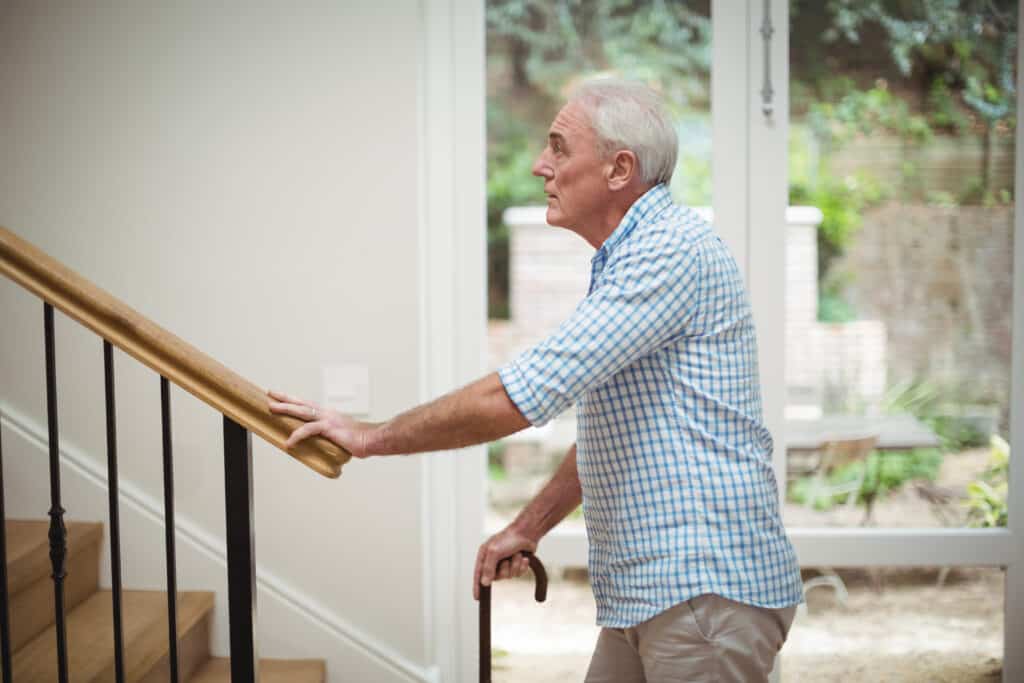
Knee pain when climbing stairs is a common issue among seniors that can be frustrating, to say the least. Still, there are many strategies that you can use to help make going up stairs more comfortable.
Here are five of the strategies that I recommend to my patients most often:
Take Advantage of Effective Warm-ups and Cool-downs
Physical activity is an essential part of our daily lives, and stairs are a common obstacle we all have to deal with. Even when you can’t avoid stairs in your route, warming up and cooling down before and after stair climbing can be a big help.
Warming up prepares your muscles and joints for the task ahead, while cooling down helps to relax them afterward. This can be as simple as a 5-minute walk or gentle stretching before climbing stairs or doing similar activities like walking up a steep hill.
Remember to focus on your lower body, particularly your legs and knees.
Invest in Comfortable Footwear
The type of shoes you wear can significantly impact your knee health, and footwear that fits well and provides adequate cushioning can help prevent knee pain when going upstairs. Supportive shoes ensure proper foot alignment, indirectly improving knee alignment and reducing strain as you ascend.
Many patients see significant improvements after getting a new pair of shoes with the proper support. Of course, new shoes often have a breaking-in period where they may be less comfortable than your old shoes, so keep this in mind when getting a new pair.
Maintain Good Posture and Alignment
Alignment is another significant factor in preventing knee pain on the stairs. When climbing stairs, keep your chest up and keep your knees aligned with your toes. This position helps even out the pressure on the knees.
Use Rails for Support
Handrails aren’t just for balance; they can also act as a support system for your knees. If you have sensitive knees, using rails can help offload some of the weight and stress from your knees onto your arms, making the ascent less painful.
If you’re going up stairs with rails on both sides, use the rail opposite your more sensitive leg. This can be counterintuitive at first, but giving yourself support on your opposite side will ultimately give you more support and prevent you from leaning toward your affected side.
Take It One Step at a Time
Lastly, if your knees are particularly painful, consider going upstairs one step at a time. This method involves leading with your stronger leg and bringing your weaker leg to the same step afterward. This reduces the work your knees have to do at once, which can help to relieve pain.
The same sequence works going downstairs, only in reverse, placing your weak leg on the step below and following with the uninjured leg.
An easy way to remember this might be, “Up with the good leg, down with the bad leg.”
As I always teach my patients, going up or down stairs one step at a time is a temporary solution. Once you see improvements in your knee pain, you can return to your typical pattern on the stairs.
These are a few practical and easy ways to prevent or reduce knee pain when climbing stairs, but prevention isn’t always possible. For this reason, knowing what treatments can be effective for your knee pain when going upstairs is essential.
Treatments to Relieve Knee Pain When Going Up Stairs

Even if you’re seeing success with prevention strategies to reduce knee pain when going up stairs, treating the root cause as best as possible is essential for long-term benefits.
Here are some of the most effective approaches for treating knee pain.
Home Remedies for Knee Pain Relief
Home remedies are typically the first line of defense when treating knee pain. Here’s what you can try:
- Rest: Giving your knees a break from strenuous activity can help reduce inflammation and pain. Rest should be relative, so stay active using activities that do not worsen your knee pain.
- Ice: Applying cold packs to your knee can help numb the area and decrease pain or swelling. Aim for 10-20 minutes as needed during your day.
- Compression: A compression bandage or knee brace can provide support and reduce swelling. These can be purchased over the counter and are usually very affordable.
- Elevation: Keeping your knee elevated above your heart can help reduce swelling by easing circulation. You can also pair elevation with ice for a two-in-one technique.
- Over-the-counter (OTC) pain relievers: Non-prescription medications like acetaminophen or ibuprofen can help manage pain and reduce inflammation. Always talk to your doctor before starting a new medication.
- Topical creams: Analgesic (pain-killing) creams or gels can be applied directly to your knee to alleviate pain.
NEENCA Compression Knee Sleeve
If you have a nagging knee pain that you want to protect from getting worse, you may benefit from wearing a compression brace with lateral support. This type of brace can reduce inflammation, improve blood flow, and provide some stability for your knee. Just remember this is a “comfort fix”, not a long-term solution. You’ll still want to follow up with your physical therapist for exercises and other therapies that can help you manage your pain and prevent further damage to your knee.
The highly rated Neenca Compression Knee Sleeve is the brace we most often recommend to our patients.
Our recommendations are the same items we trust and prescribe to patients. When you buy through links like this on our site, we may earn an affiliate commission to support new content.
Most people will see results with some combination of the above but remember that these treatments are designed to get temporary results so that you can focus on more active treatments.
Always follow the instructions on the package with any of these treatments, and consult your healthcare provider if you experience any new or concerning symptoms.
Physical Therapy for Knee Pain
Physical therapy is another powerful tool in treating knee pain. A physical therapist is a movement and recovery expert who can recommend exercises and stretches to build strength and flexibility in your knee, potentially reducing pain and improving your ability to climb stairs.
A significant part of physical therapy is finding out why you’re having knee pain in the first place so that the root cause can be addressed for longer-lasting improvements.
In most cases, exercise and manual therapy will be the most critical techniques to reduce pain and improve strength. Depending on your situation, tools like massage or electrical stimulation might also be used.
The Role of Weight Loss in Knee Health
Carrying extra weight around puts significant additional stress on your knees. In fact, for every pound of body weight, the knee takes many more pounds of pressure when you walk or climb stairs. For this reason, maintaining a healthy weight can significantly reduce knee pain and help prevent future problems.
Weight loss can be intimidating, but plenty of helpful resources are available for older adults to reach and maintain a healthy weight. To help you get started, talk to your doctor or physical therapist for more resources.
Tailoring the Treatment to the Cause
The best treatment for you depends on the cause of your knee pain. For instance, if your pain is due to arthritis, a combination of weight management, physical therapy, and pain relievers might be the best approach for you.
Suppose your knee pain is due to an injury that requires medical treatment to see improvements. In that case, you may be recommended to have an injection or wear a special brace for a set period before starting physical therapy and exercise.
Each treatment has its benefits, and not every treatment suits everyone. Always consult your healthcare provider before starting any new treatment plan.
Summary
Navigating the stairs shouldn’t be daunting, yet knee pain makes each step challenging for many older adults. Through my experience in physical therapy, I’ve seen firsthand the impact of conditions like osteoarthritis, patellofemoral pain syndrome, and tendonitis on this everyday activity. However, there’s hope. We can manage discomfort by understanding the root causes of knee pain and adopting targeted strategies, such as warming up properly, choosing the right footwear, and utilizing handrails. Moreover, embracing home remedies and physical therapy offers immediate relief and paves the way for long-term improvement.
Tailoring treatment to the individual’s needs is key, focusing on strengthening exercises, weight management, and proper posture during stair climbing. It’s essential to remember that while the journey towards overcoming knee pain may require patience and persistence, the rewards of regained mobility and independence are well worth the effort. Always consult with a healthcare provider to ensure a safe and effective approach to managing knee pain, and keep climbing towards better health and a more active lifestyle.
Key Takeaways
- Knee pain when going up stairs is common among older adults and can be caused by osteoarthritis, patellofemoral pain syndrome, chondromalacia, or tendonitis.
- Climbing stairs requires more effort from the knee joint than walking on flat ground, which can exacerbate knee pain.
- Practical strategies to manage knee discomfort on stairs include effective warm-ups, maintaining good posture, using supportive footwear, and utilizing handrails for support.
- Home remedies such as rest, ice, compression, elevation, pain relievers, and creams can help to relieve knee pain.
- Physical therapy focuses on exercises and stretches to build strength and flexibility, addressing the root cause of knee pain for longer-lasting improvement.
- Maintaining a healthy weight reduces knee stress, potentially alleviating pain and preventing future issues.
- Tailoring treatments to the specific cause of knee pain is crucial, with options ranging from medication and physical therapy to weight management and lifestyle changes.
- Before starting any new treatment plan, consulting with healthcare providers ensures that interventions are safe and suited to individual health needs.
References
- Osteoarthritis. Centers for Disease Control and Prevention.
- Gaitonde DY, Ericksen A, Robbins RC. Patellofemoral Pain Syndrome. Am Fam Physician. 2019;99(2):88-94.
- Habusta SF, Coffey R, Ponnarasu S, et al. Chondromalacia Patella. [Updated 2023 Apr 22]. In: StatPearls [Internet]. Treasure Island (FL): StatPearls Publishing; 2024 Jan-.
- Patellar Tendinopathy: Clinical Diagnosis, Load Management, and Advice for Challenging Case PresentationsPeter Malliaras, Jill Cook, Craig Purdam, and Ebonie RioJournal of Orthopaedic & Sports Physical Therapy 2015 45:11, 887-898
- Jacklyn Heino Brechter, Christopher M Powers. Patellofemoral joint stress during stair ascent and descent in persons with and without patellofemoral pain. Gait & Posture. Volume 16, Issue 2, 2002, Pages 115-123. ISSN 0966-6362.

